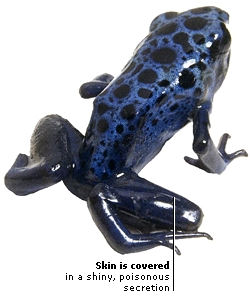DK Science: Defence
Animals have evolved many ways of protecting themselves from PREDATORS. Most use their keen senses to detect an attack and make a dash for safety. Some animals are able to camouflage themselves. Others have sharp spines, produce poisons, or make themselves look bigger than they actually are. A few animals lose limbs or tails deliberately as a means of escape, only to regenerate them later. Nevertheless, predators have also evolved – and are better at catching prey.

Some amphibians defend themselves by producing poisons. Predators of poison- dart frogs, such as snakes and spiders, are not harmed by mild poisons. So these frogs have evolved highly poisonous skin secretions that are unpleasant or even lethal to their predators. These frogs have also developed colourful markings to warn predators that they are dangerous.

Several animals, including porcupines and sea urchins, have spines for defence. The spiny puffer fish has spines but also another form of defence. When attacked, it inflates its body by swallowing large amounts of water. As its body swells, the spines stand up. The swollen fish sticks in the throat of any attacker and cannot be swallowed.

Snakes have two methods for killing large prey. Venomous snakes bite their quarry, injecting venom that affects the quarry’s nervous or circulatory systems. Constricting snakes grab their prey and suffocate it by throwing coils of their body around it. They strike with great speed but may take several hours to eat a large animal.
Many butterflies have markings known as false eyes on their wings. Those of the owl butterfly mimic the eyes of an owl and so frighten off small birds that might normally be eaten by owls.
Many flatfish that rest on the sea floor, such as plaice, are able to change the colour of their skin to match the ground they are lying on. This makes them almost invisible to predators. Just under the surface of their skin, there are special cells that can become lighter or darker. Other animals that can change colour to match their surroundings include chameleons and squid.
Some lizards, such as the skink, can shed part of their tail if they are attacked from behind. The tail continues to move in the attacker’s mouth, drawing attention away from the escaping skink. The skink is then able to grow another tail.
Animals that kill other animals for food are called predators. Predation is the main reason why a creature of one species attacks a member of another species. Animals being attacked may defend their young or family group, but in most cases they try and escape capture. Some creatures eat members of their own species – usually the eggs or younger members. Predators may actively hunt for food or lie in wait to catch it.
African hunting dogs take it in turns to head the chase so they can wear out the prey before they wear out themselves. When the prey eventually tires, they all move in together for the kill. Several types of mammal predators hunt in groups. This allows them to tackle prey that would be too big, dangerous, or tiring for them to tackle alone.
